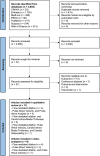Efficacy of exercise training for improving vascular dysfunction in people with cancer: a systematic review with meta-analyses
- PMID: 37079184
- PMCID: PMC11324680
- DOI: 10.1007/s11764-023-01372-7
Efficacy of exercise training for improving vascular dysfunction in people with cancer: a systematic review with meta-analyses
Abstract
Purpose: Cancer treatments exert vascular toxic effects that can lead to the development of cardiovascular disease. Exercise training has the potential to prevent or reduce cancer treatment-induced damage to vascular structure and function. This systematic review with meta-analyses aimed to determine the isolated effects of exercise training on vascular outcomes in people with cancer.
Methods: Seven electronic databases were searched on 20 September 2021 to identify randomised controlled trials, quasi-randomised trials, pilot and cohort studies. Included studies implemented a structured exercise intervention and assessed vascular structure and/or function in people during or following cancer treatment. Meta-analyses examined the effects of exercise training on endothelial function (via brachial artery flow-mediated dilation) and arterial stiffness (via pulse wave velocity). Methodological quality was assessed using the Cochrane Quality Assessment tool and modified Newcastle-Ottawa Quality Appraisal tool. Grading of Recommendations, Assessment, Development and Evaluations framework was used to assess the certainty of evidence.
Results: Ten studies (discussed across 11 articles) met the inclusion criteria. Methodological quality of the included studies was moderate (71% average). Exercise improved vascular function when compared to control (standardised mean difference = 0.34, 95% CI (0.01, 0.67); p = 0.044: studies = 5, participants = 171), but not pulse wave velocity (standardised mean difference = - 0.64, 95% CI (- 1.29, 0.02); p = 0.056: studies = 4, participants = 333). The certainty of evidence was moderate for flow-mediated dilation and low for pulse wave velocity.
Conclusions: Compared to usual care, exercise training significantly improves flow-mediated dilation (endothelial function) but not pulse wave analysis, in people treated for cancer.
Implications for cancer survivors: Exercise may improve vascular health in individuals during and following cancer treatment.
Keywords: Cardiotoxicity; Carotid intima-media thickness; Exercise physiology; Neoplasms; Physical activity; Pulse wave analysis.
© 2023. The Author(s).
Conflict of interest statement
The authors declare no competing interests.
Figures



References
-
- Sung H, Ferlay J, Siegel RL, Laversanne M, Soerjomataram I, Jemal A, Bray F. Global cancer statistics 2020: GLOBOCAN estimates of incidence and mortality worldwide for 36 cancers in 185 countries. CA: Cancer J Clin. 2021;71:209–49. 10.3322/caac.21660. - PubMed
-
- Australian Institute of Health and Welfare Cancer data in Australia. 2021. https://www.aihw.gov.au/reports/cancer/cancer-data-in-australia/contents.... Accessed 12 August 2021.
-
- American Cancer Society. Cancer facts & figures. 2019. https://www.cancer.org/content/dam/cancer-org/research/cancer-facts-and-.... Accessed 12 August 2021.
-
- Curigliano G, Lenihan D, Fradley M, Ganatra S, Barac A, Blaes A, Herrmann J, Porter C, Lyon AR, Lancellotti P, Patel A, DeCara J, Mitchell J, Harrison E, Moslehi J, Witteles R, Calabro MG, Orecchia R, de Azambuja E, et al. Management of cardiac disease in cancer patients throughout oncological treatment: ESMO consensus recommendations. Ann Oncol. 2020;31:171–90. 10.1016/j.annonc.2019.10.023. 10.1016/j.annonc.2019.10.023 - DOI - PMC - PubMed
Publication types
MeSH terms
LinkOut - more resources
Full Text Sources
Medical
Miscellaneous

